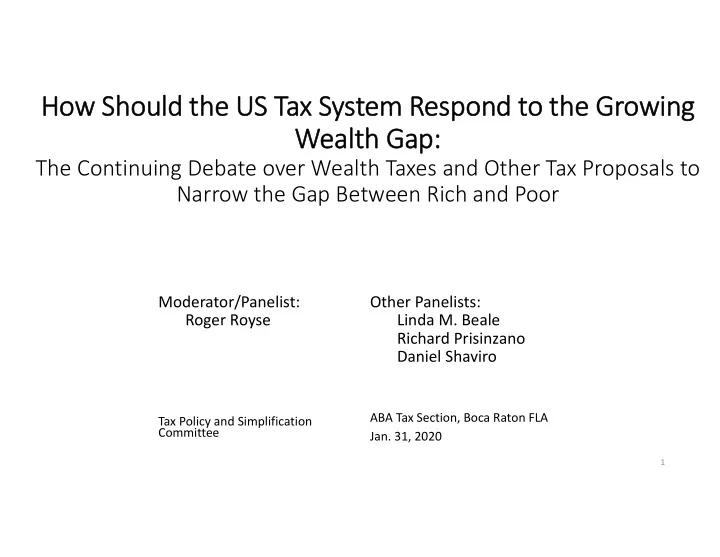

How How Should Should the the US US Ta Tax Syste System Re Respond to to the the Gr Growing owing We Wealth Gap: Gap: The Continuing Debate over Wealth Taxes and Other Tax Proposals to Narrow the Gap Between Rich and Poor Moderator/Panelist: Other Panelists: Roger Royse Linda M. Beale Richard Prisinzano Daniel Shaviro ABA Tax Section, Boca Raton FLA Tax Policy and Simplification Committee Jan. 31, 2020 1
Kleinbard’s Dual BEIT Proposal • Comprehensive business income tax reform proposal that has received surprisingly little attention. • Main aims include: (1) avoid distorting business choices re. organizational form, financing methods, asset choice; (2) thereby reduce the efficacy of tax planning; (3) shift taxation of certain “normal” returns from the entity level to the individual level; (4) address use of corporations as a tax shelter for owner ‐ employees’ undistributed labor income. 32
A few key details of the Dual BEIT • All businesses (not just C corporations) are taxed at (say) 25%. • They get a cost of capital allowance (COCA) deduction. • COCA deduction = tax basis in capital investments X the Treasury bond rate (say). • Results in exempting “normal” returns at the entity level. • Makes the entity ‐ level tax expensing ‐ equivalent (a la cash flow consumption taxes) BUT: • Individual owners (of debt, equity, or anything else) pay tax on the COCA rate X their basis. • So the normal investment return is taxable after all, but directly to individuals rather than to entities. • “Superconsolidation” rules for related entities, so WW tax on expensing ‐ equivalent base. • Applies “labor ‐ capital income centrifuge” to companies’ extra ‐ normal returns that are deemed to represent controlling owner ‐ employees’ undistributed labor earnings. • E.g., Facebook might face higher tax rate on deemed salary underpayments to Mark Zuckerberg. 33
The Dual BEIT and Wealth Inequality • A central aim is simply to rationalize business income taxation (rather than addressing inequality as an end in itself) . • But: (1) Could make it easier to tax US individuals’ “normal” returns at a positive rate. Individual vs. corporate residence, inside vs. outside basis, defeats various types of tax planning, mitigates realization woes. (2) Addresses use of lower corporate rate as a tax shelter. E.g., why tax Zuckerberg’s undistributed share of Facebook earnings @ only 21%? (3) Rationalizing business income taxation may be key to retaining income taxes’ role as a distributional tool. 34
Higher & More Progressive Income Tax Rates? • For decades, economists (even on the left) tended to favor relatively lowish & flattish rates compared to pre ‐ 1981 U.S. practice. • E.g., the optimal income tax (OIT) literature founded in the 1970s by the Nobel Prize ‐ winning James Mirrlees . • But such consensus is now gone. • E.g., see work by Peter Diamond (also a Nobelist) & Emmanuel Saez urging a top rate in the neighborhood of 70%. • They argue that this would (or could) be the revenue ‐ maximizing rate at the top. 35
A 70 percent top income tax rate? • Issues being debated include (a) what is (or could be) the revenue ‐ maximizing rate at the top, (b) whether the choice of such a rate (or even a higher one!) is desirable, and (c) how the “top” ought to be defined for this purpose. • Having such a high rate is far from unprecedented in the US – including in high ‐ growth eras – but suppose it was more of a true effective rate than previously. • Vs. changing the tax base, raising top rates has (a) the disadvantage of magnifying existing distortions, but also (b) the advantage of avoiding the imponderables associated with making big structural changes. 36
Higher estate and gift tax rates? • Another way of addressing the rise of high ‐ end wealth inequality would be to raise estate & gift tax rates. • This could be accompanied (or not) by tax base changes aimed at addressing estate & gift tax planning. • Exemption amounts could also be reduced, depending on the proponents’ particular distributional aims. • Vs. using wealth taxation, its pros include (a) familiarity & constitutionality, (b) its not needing annual valuations, & (c) its addressing inheritance in particular (if one views dynastic wealth as the problem) . • Its cons include its (a) inviting the use of a greater range of tax planning responses, (b) relying on asset valuations at very specific times that may be idiosyncratic. 37
Recommend
More recommend